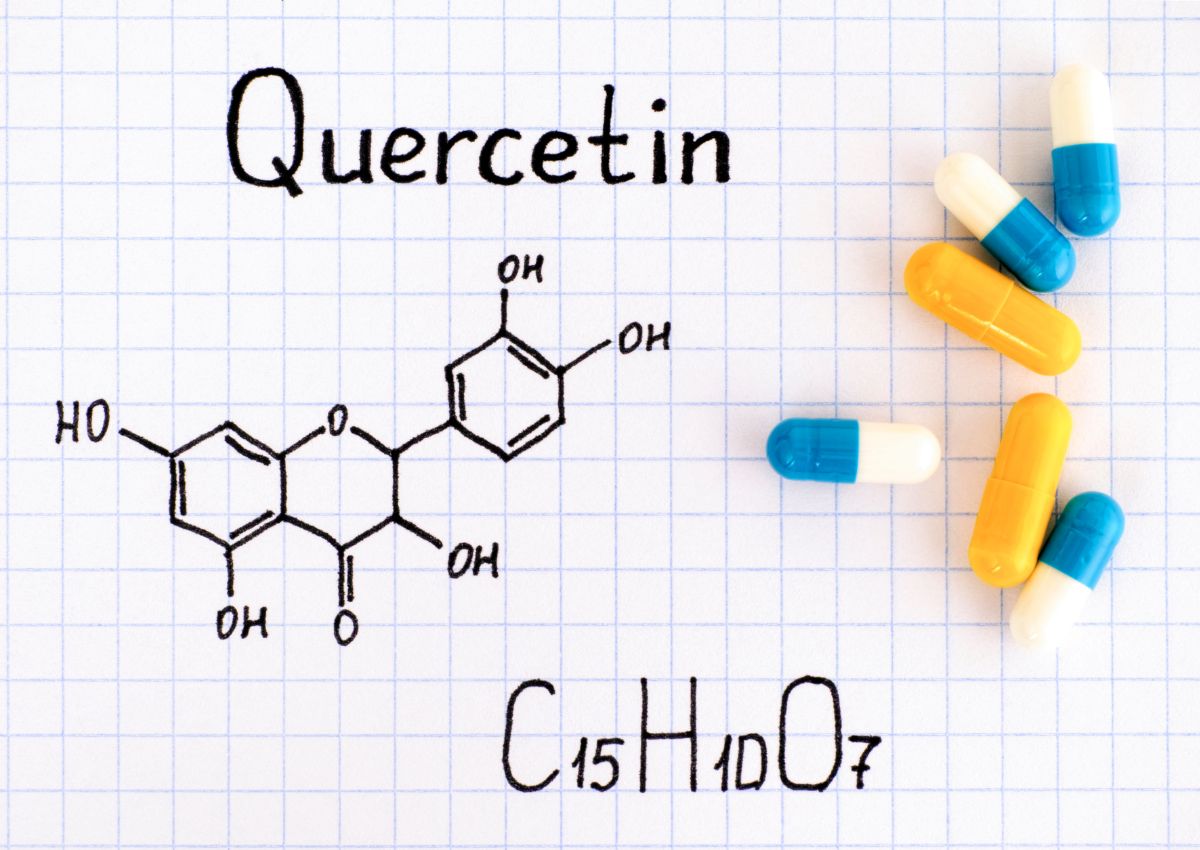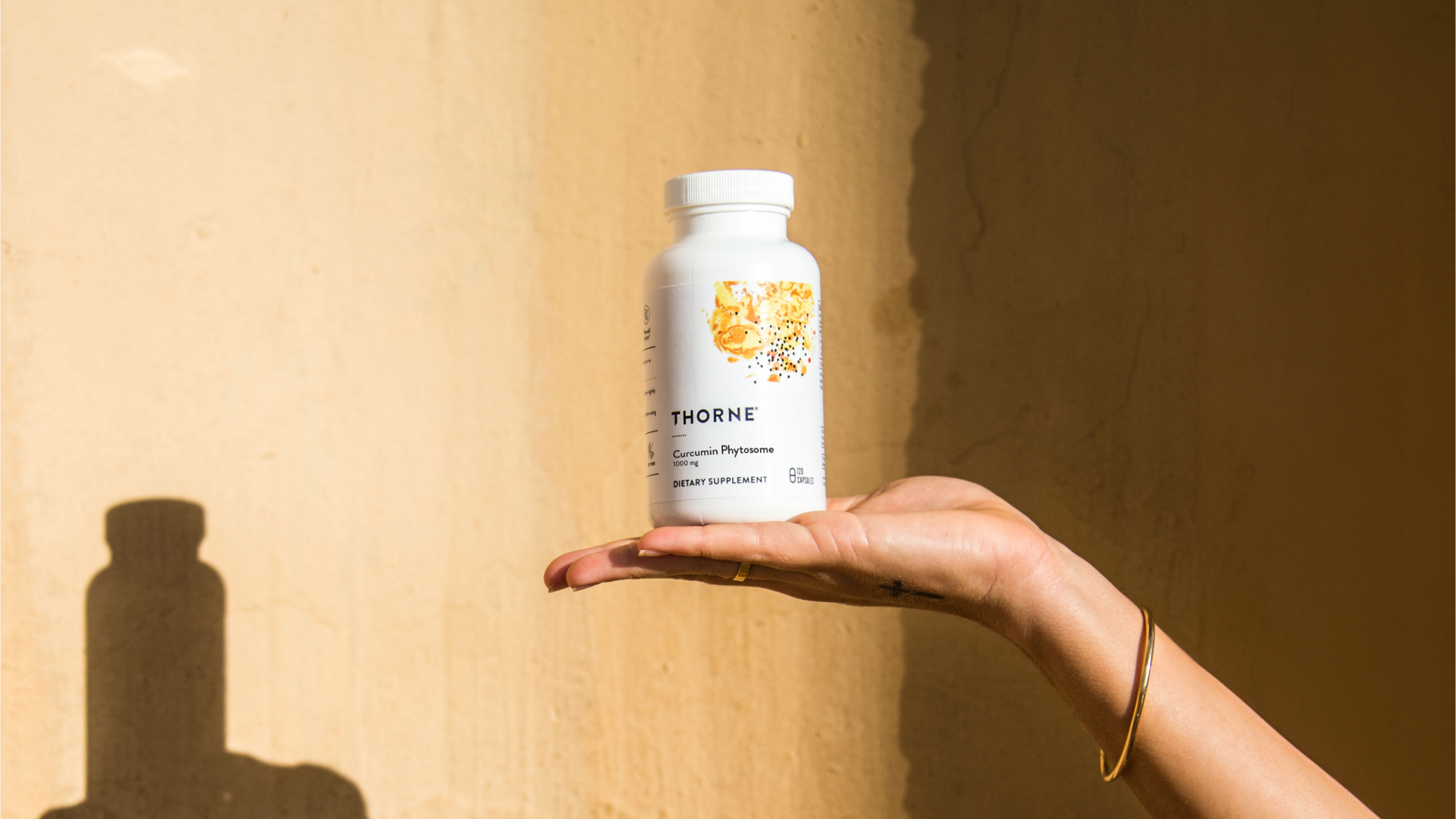Thorne has always been on the cutting edge of new flavonoid product introductions – including quercetin.
Quercetin – the what, where and how
What. Although it’s likely you’ve heard of quercetin supplements, you might not be familiar with what quercetin is and does. First some biochemistry – okay, just a little. All flavonoids contain three carbon rings with OH groups (oxygen and hydrogen) attached. Because this gives rise to many molecular combinations and a multitude of substitutions, approximately 6,000 flavonoids have been identified in the plant world – quercetin being the most abundant.1 Flavonoids are subdivided based on their molecular structure into: isoflavones, flavonols (quercetin is part of this subgroup), flavones, flavanones, flavan-3-ols, and anthocyanidins.2 End of biochemistry.
Where. Quercetin is in many foods, including apples, onions, tea, berries and cruciferous (cabbage family) vegetables, as well as in many seeds, nuts, flowers, barks and leaves. It is also found in medicinal botanicals, including Ginkgo biloba, Hypericum perforatum (St. John’s wort), Sambucus canadensis (elder) plus many others, and is often a component of the medicinal activity of the plant.
How. First and foremost, quercetin is a potent antioxidant – a function that contributes to many of its therapeutic benefits. It also impacts enzymes associated with inflammatory cytokines, contributing to a balanced inflammatory response. Quercetin’s antioxidant and inflammatory response-balancing effects contribute to far reaching benefits throughout the body.
Let’s take a look at some of the most important ways you can benefit from eating foods high in quercetin or taking a nutritional supplement that contains quercetin.

Four ways quercetin can benefit your health
1. Seasonal allergies
One of the most recognised health benefits is nutritional support from quercetin for allergy sufferers – particularly seasonal allergies that blow in on the wind. And “seasonal” can basically be anytime, depending on where you live. For example, the Santa Ana winds in Southern California can kick up the pollen, even in January.
How does quercetin work? First a little background. There are two types of white blood cells that release histamine – mast cells and basophils. Histamine is the chemical that causes those unpleasant allergy-related symptoms, like sneezing, watery eyes and scratchy throat. Quercetin provides benefit because it helps keep mast cells and basophils from releasing histamine.
A double-blind study of individuals with pollen allergies found a well-absorbed form of quercetin (as a phytosome – see more about this below) improved both quality of life and symptoms, such as sneezing, itchy eyes, and runny nose, in the participants who took quercetin.3
2. Immune Support
Quercetin interacts with the immune system in several positive ways. For example, quercetin appears to up-regulate T-helper 1 cells, while down-regulating the T-helper 2 response.4 This modulating effect helps balance immune function – inhibiting it from becoming overactive – like what happens when you have an allergy or an autoimmune condition.
In clinical studies, quercetin has been shown to reduce the tendency to become sick after periods of intense exercise – a time when the body’s immune function is often weakened. In one study, trained cyclists who participated in three days of intense cycling were given quercetin before, during, and for two weeks after the event.5 Only one of 20 cyclists in the quercetin group got sick during the 2-week post-exercise period, whereas nine of 20 in the placebo group did. This apparent support for immune function could be due, at least in part, to quercetin’s potent antioxidant effects because heavy exercise induces oxidative stress.
3. Healthy ageing
Quercetin supports healthy ageing in several ways. As an antioxidant, it protects cells against damage from free radicals.
Quercetin is also a senolytic. A seno- what? As our cells age, a process called senescence begins to occur. Normally, a cell continues to divide until it gets old and dies, is removed from the body, and is replaced by a new cell – like the approximately 100 billion cells that die and are replaced in our body each day. However, as we age, some cells stop dividing, but they don’t die. Even though they are useless to us, these cells, called senescent cells, are not removed from the body. Some of the same factors that cause free radicals also cause cell senescence. Senescent cells can build up in the body and contribute to chronic disease because they secrete inflammatory chemicals that damage healthy cells.
Enter quercetin. Although the science of senescence is still in its infancy, it turns out quercetin has been found to help clear senescent cells – “zombie cells” – from the body.6 Cellular senescence is regulated by a protein called a sirtuin (SIRT1 specifically). Quercetin can turn on this protein.7
Mayo Clinic has been investigating cellular senescence and ageing for more than a decade. Some of their research looked at quercetin and a drug called dasatininb. Mayo researchers fed mice a compound they previously proved could selectively kill senescent cells: dasatinib, a drug used with chemotherapy, and quercetin, a flavonoid found in onions and apples. The result? Within weeks after receiving treatment, the mice ran further, did better on physical testing, and were 36% less likely to die than mice injected with senescent cells who didn’t receive the drug.8,9
You can read more about senescence in this blog from our partners at Mayo Clinic.
4. Exercise recovery
Because of quercetin’s antioxidant effects and the connection between intense exercise and oxidative stress, quercetin has been put to the test in various sporting scenarios. A review of 13 studies found quercetin (1,000mg/day in all but one study) for periods of one to 12 weeks improved post-exercise muscle damage, soreness and recovery time.10
In a pilot study of amateur triathlon athletes, quercetin phytosome (250mg twice daily of quercetin; 500mg total per day) improved post-exercise muscle pain, cramping and recovery time compared to a control group who did not take anything.11
In addition to these better known uses, quercetin has also been studied in a broad range of other scenarios, including for cardiovascular, gastrointestinal, urinary tract, and joint support.
Quercetin absorption
As noted above, quercetin is poorly absorbed. Quercetin supplements that contain quercetin a phytosome help to overcome this limitation. Quercetin is bound to phospholipids, creating a “phytosome” that ushers the flavonoid across phospholipid-rich cell membranes and into the bloodstream. In a study of 12 healthy volunteers, quercetin phytosome demonstrated 20-times better absorption that unbound quercetin.12
Explore FxMed’s Quercetin Containing Products
Visit www.fxmed.co.nz/practhub > Browse by Ingredient > Check-box Quercetin (see below visual).

Available on request.
Share:
Related Posts

Thorne Celebrates 40 Years of Good Health
Maggie Chandler April 12, 2024 As it’s often said at Thorne, healthy ageing is a gift. It’s about embracing the way you feel, your experiences,

Healthy Coffee Alternatives: When to Quit Coffee & What to Drink Instead
Dr Thomas Wnorowski February 16, 2024 Key Points: Does the idea of quitting coffee make you feel all sorts of (terrible) things? It’s common. But

How Your Social Network Impacts Your Mental Health
Austin Ruff April 17, 2024 Humans are inherently social creatures. It’s in our nature to connect and want to be connected to the people around

Microbiota-Gut-Brain Axis: Behaviour and Dementia Implications
People take supplements to improve or optimize their health. So what happens when you look at the label, and the ingredient list is filled with

Gut Bacteria and GABA
People take supplements to improve or optimize their health. So what happens when you look at the label, and the ingredient list is filled with


